sensor MERCEDES-BENZ CL-Class 2014 C217 Owner's Manual
[x] Cancel search | Manufacturer: MERCEDES-BENZ, Model Year: 2014, Model line: CL-Class, Model: MERCEDES-BENZ CL-Class 2014 C217Pages: 494, PDF Size: 13.55 MB
Page 9 of 494

Car
see Vehicle
Care
Carpet s.......................................... 433
Car wash ........................................ 427
Display ........................................... 431
Exterior lights ................................ 430
Gea rors electo rlever .................... 433
Interior ........................................... 431
Matte finish ................................... 429
Nigh tView Assist Plus ...................432
Notes ............................................. 427
Paint .............................................. 429
Plastic trim .................................... 432
Power washer ................................ 428
Rea rview camera .......................... 431
Roof lining ...................................... 433
Seat bel t........................................ 433
Seat cover ..................................... 433
Sensors ......................................... 431
Steering wheel ............................... 433
Tai lpipes ....................................... 431
Trim pieces .................................... 433
Washing by hand ........................... 428
Wheels ........................................... 429
Windows ........................................ 430
Wiper blades .................................. 430
Wooden trim .................................. 433
Cargo tie down rings .........................402
Car pool lanes .................................... 157
Car wash (care) ................................. 427
Category Satellite radio ................................ 206
CD
Cop yprotection ............................. 218
Fast forward/fast rewind ...............214
General information .......................218
Inserting ........................................ 209
Mode ,switchin gto........................ 210
Multisession .................................. 217
Notes on discs ............................... 218
Operating the player/changer
(on-board computer) ......................343
Pause function ............................... 211
Playback options ........................... 216
Player/change roperation
(COMAND )..................................... 209
Safety notes .................................. 209Selecting
amedia type .................. 212
Selecting atrack ............................ 213
Sound settings (balance, bass,
fader, treble ).................................. 128
Cell phone
see Mobile phone
Center console ..................................... 39
Central locking Automatic locking feature
(COMAND) ..................................... 239
SmartKey ......................................... 74
Changing bulbs
High-beam headlamps ...................257
Important safety notes ..................256
Overview of bul btypes .................. 257
Changing direction
Announcement phase ....................154
Change of direction phase .............155
Preparation phase .........................154
Changing the programming
SmartKey ......................................... 77
Character bar ..................................... 122
Characters Entering ......................................... 123
Entering (address book, phone
book) ............................................. 125
Entering (navigation) ......................122
Child-proof locks
Important safety notes ....................63
Children
In the vehicle ................................... 59
Restraint systems ............................ 59
Child seat
LATCH-type (ISOFIX) child seat
anchors ............................................ 62
Specia lseat belt retractor ...............61
Top Tether ....................................... 63
Cigarette lighter ................................ 406
Cleaning Mirro rturn signal ........................... 431
Climate control
Automatic climate control .............263
COMAND ....................................... 239
Controlling automatically ...............264
Controlling centrally (COMAND) ....242
Cooling with aird ehumidification..264
Cooling with aird ehumidification
(COMAND )..................................... 241 Index
7
Page 16 of 494
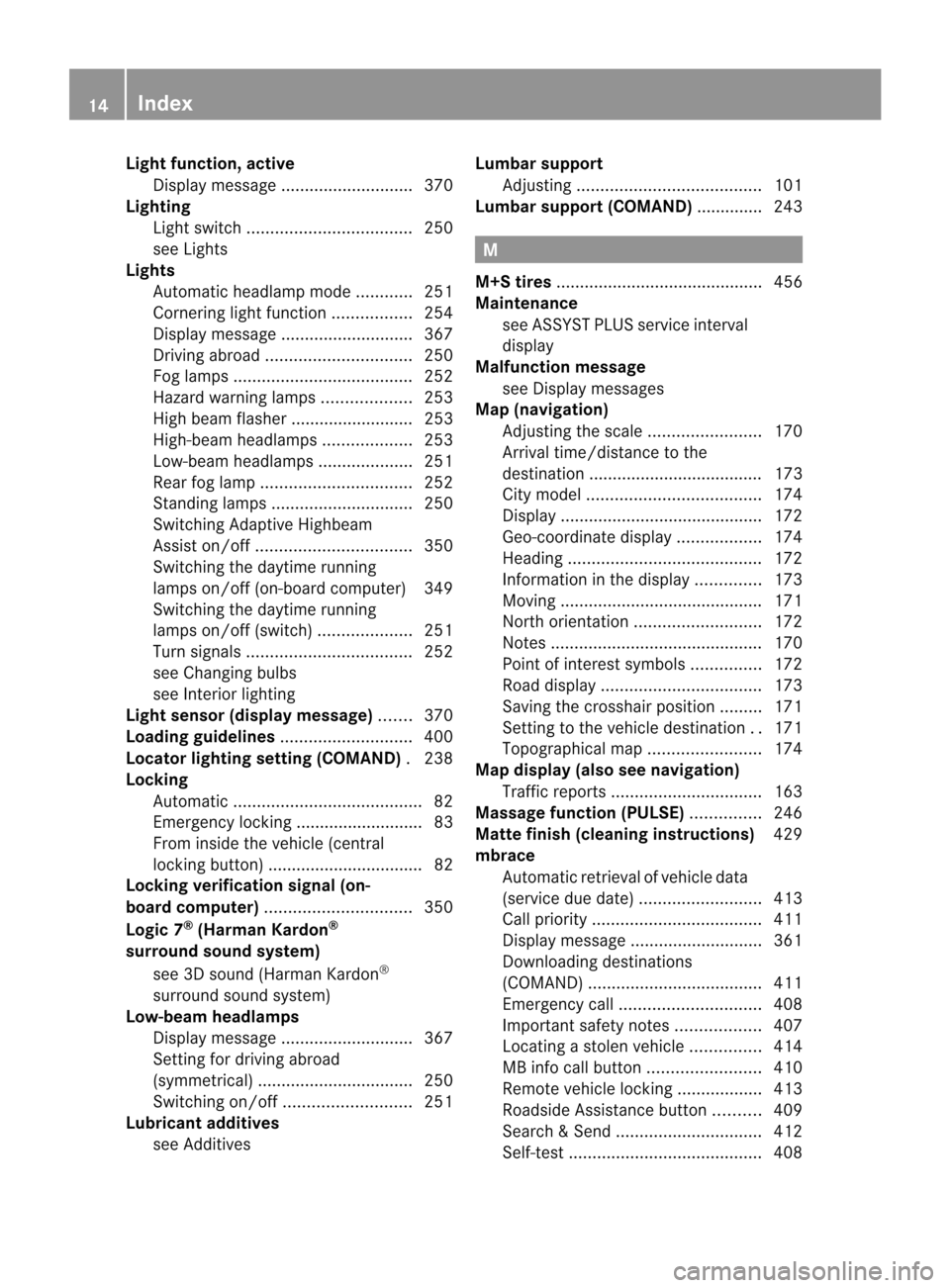
Light function, active
Display message ............................ 370
Lighting
Ligh tswitc h................................... 250
see Lights
Lights
Automatic headlamp mode ............251
Cornering light function .................254
Display message ............................ 367
Driving abroad ............................... 250
Fog lamps ...................................... 252
Hazard warning lamps ...................253
High beam flasher .......................... 253
High-beam headlamps ...................253
Low-beam headlamps ....................251
Rea rfog lamp ................................ 252
Standing lamps .............................. 250
Switching Adaptive Highbeam
Assist on/off ................................. 350
Switching the daytime running
lamps on/off (on-board computer) 349
Switching the daytime running
lamps on/off (switch) ....................251
Turn signals ................................... 252
see Changing bulbs
see Interior lighting
Light sensor (display message) .......370
Loading guidelines ............................400
Locator lighting setting (COMAND) .238
Locking Automatic ........................................ 82
Emergency locking ........................... 83
From inside the vehicle (central
locking button) ................................. 82
Locking verification signal (on-
board computer) ............................... 350
Logic 7 ®
(Harman Kardon ®
surround sound system) see 3D sound (Harman Kardon ®
surround sound system)
Low-beam headlamps
Display message ............................ 367
Setting for driving abroad
(symmetrical) ................................. 250
Switching on/off ........................... 251
Lubricant additives
see Additives Lumbar support
Adjusting ....................................... 101
Lumbar support (COMAND) .............. 243 M
M+S tires ............................................ 456
Maintenance see ASSYST PLUS service interval
display
Malfunction message
see Display messages
Map (navigation)
Adjusting the scal e........................ 170
Arrival time/distance to the
destination ..................................... 173
City mode l..................................... 174
Display ........................................... 172
Geo-coordinate displa y.................. 174
Heading ......................................... 172
Information in the displa y.............. 173
Moving ........................................... 171
North orientation ........................... 172
Notes ............................................. 170
Point of interest symbols ...............172
Roa ddisplay .................................. 173
Saving the crosshair position .........171
Setting to the vehicle destination ..171
Topographica lmap........................ 174
Map display (also see navigation)
Traffi creports ................................ 163
Massage function (PULSE) ...............246
Matte finish (cleaning instructions) 429
mbrace Automatic retrieval of vehicle data
(service due date ).......................... 413
Call priority .................................... 411
Display message ............................ 361
Downloading destinations
(COMAND) ..................................... 411
Emergency call .............................. 408
Important safety notes ..................407
Locating astolen vehicl e............... 414
MB info call button ........................410
Remote vehicle locking ..................413
Roadside Assistance button ..........409
Search &Send ............................... 412
Self-test ......................................... 40814
Index
Page 19 of 494
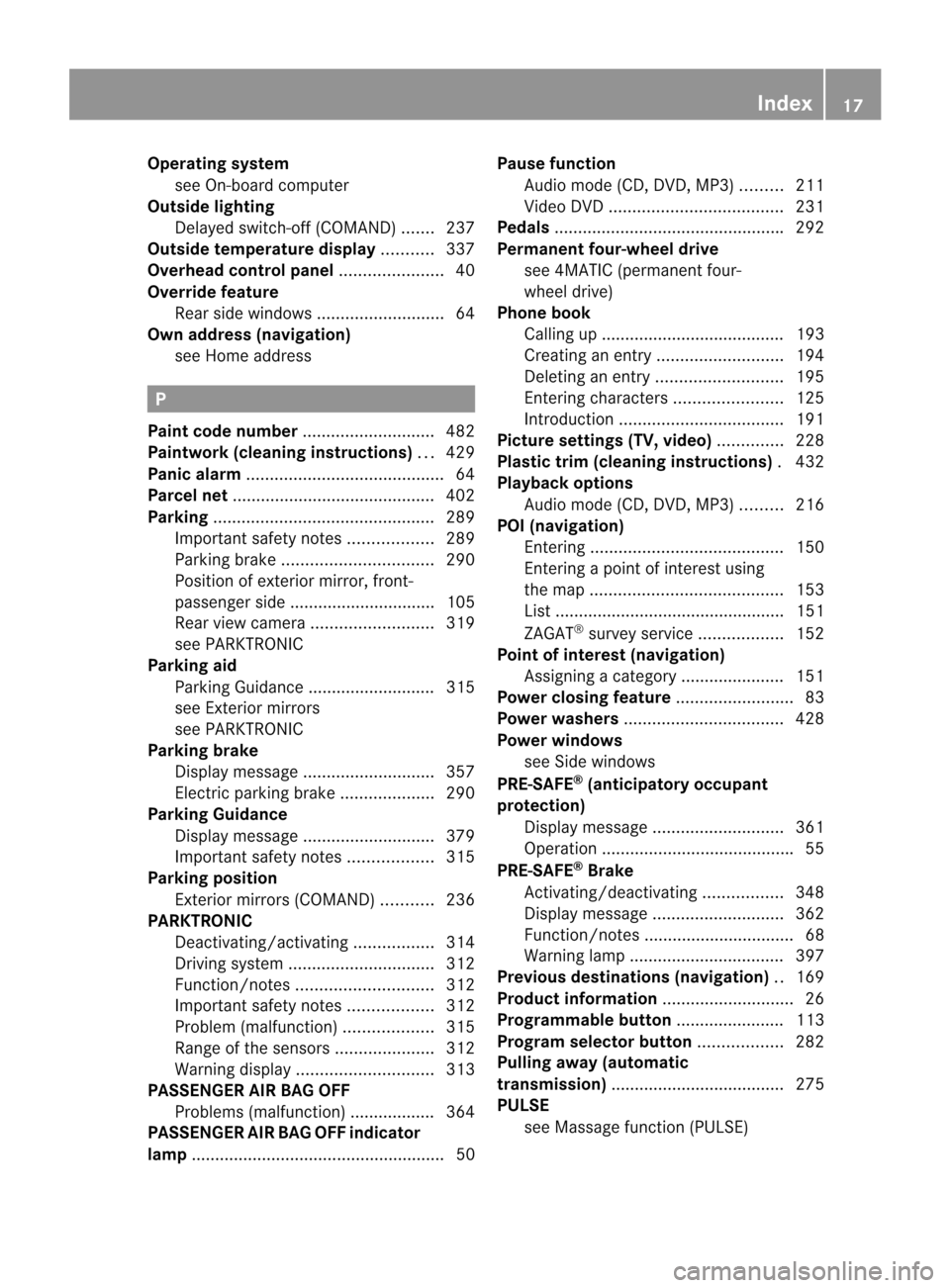
Operating system
see On-board computer
Outside lighting
Delayed switch-off (COMAND) .......237
Outside temperature display ...........337
Overhead control panel ......................40
Override feature Rea rside windows ........................... 64
Own address (navigation)
see Home address P
Pain tcode number ............................ 482
Paintwork (cleaning instructions) ...429
Panic alarm .......................................... 64
Parcel net ........................................... 402
Parking ............................................... 289
Important safety notes ..................289
Parking brake ................................ 290
Position of exterior mirror, front-
passenger side ............................... 105
Rea rview camera .......................... 319
see PARKTRONIC
Parking aid
Parking Guidance ........................... 315
see Exterior mirrors
see PARKTRONIC
Parking brake
Display message ............................ 357
Electric parking brake ....................290
Parking Guidance
Display message ............................ 379
Important safety notes ..................315
Parking position
Exterior mirrors (COMAND) ...........236
PARKTRONIC
Deactivating/activating .................314
Driving system ............................... 312
Function/notes ............................. 312
Important safety notes ..................312
Problem (malfunction) ...................315
Range of the sensors .....................312
Warning displa y............................. 313
PASSENGE RAIR BAG OFF
Problems (malfunction) .................. 364
PASSENGER AIR BAG OFF indicator
lamp ...................................................... 50 Pause function
Audio mode (CD, DVD, MP3) .........211
Video DVD ..................................... 231
Pedals ................................................ .292
Permanent four-wheel drive see 4MATIC (permanent four-
wheel drive)
Phone book
Calling up ....................................... 193
Creating an entry ........................... 194
Deleting an entry ........................... 195
Entering characters .......................125
Introduction ................................... 191
Picture settings (TV, video) ..............228
Plastic trim (cleaning instructions) .432
Playback options Audio mode (CD, DVD, MP3) .........216
POI (navigation)
Entering ......................................... 150
Entering a point of interest using
the map ......................................... 153
List ................................................. 151
ZAGAT ®
surve yservice .................. 152
Point of interest (navigation)
Assigning a category ..................... .151
Power closing feature .........................83
Power washers .................................. 428
Power windows see Side windows
PRE-SAFE ®
(anticipatory occupant
protection) Display message ............................ 361
Operation ........................................ .55
PRE-SAFE ®
Brake
Activating/deactivating .................348
Display message ............................ 362
Function/notes ................................ 68
Warning lamp ................................. 397
Previous destinations (navigation) ..169
Product information ............................26
Programmable button ....................... 113
Program selector button ..................282
Pulling away (automatic
transmission) ..................................... 275
PULSE see Massag efunction (PULSE) Index
17
Page 20 of 494
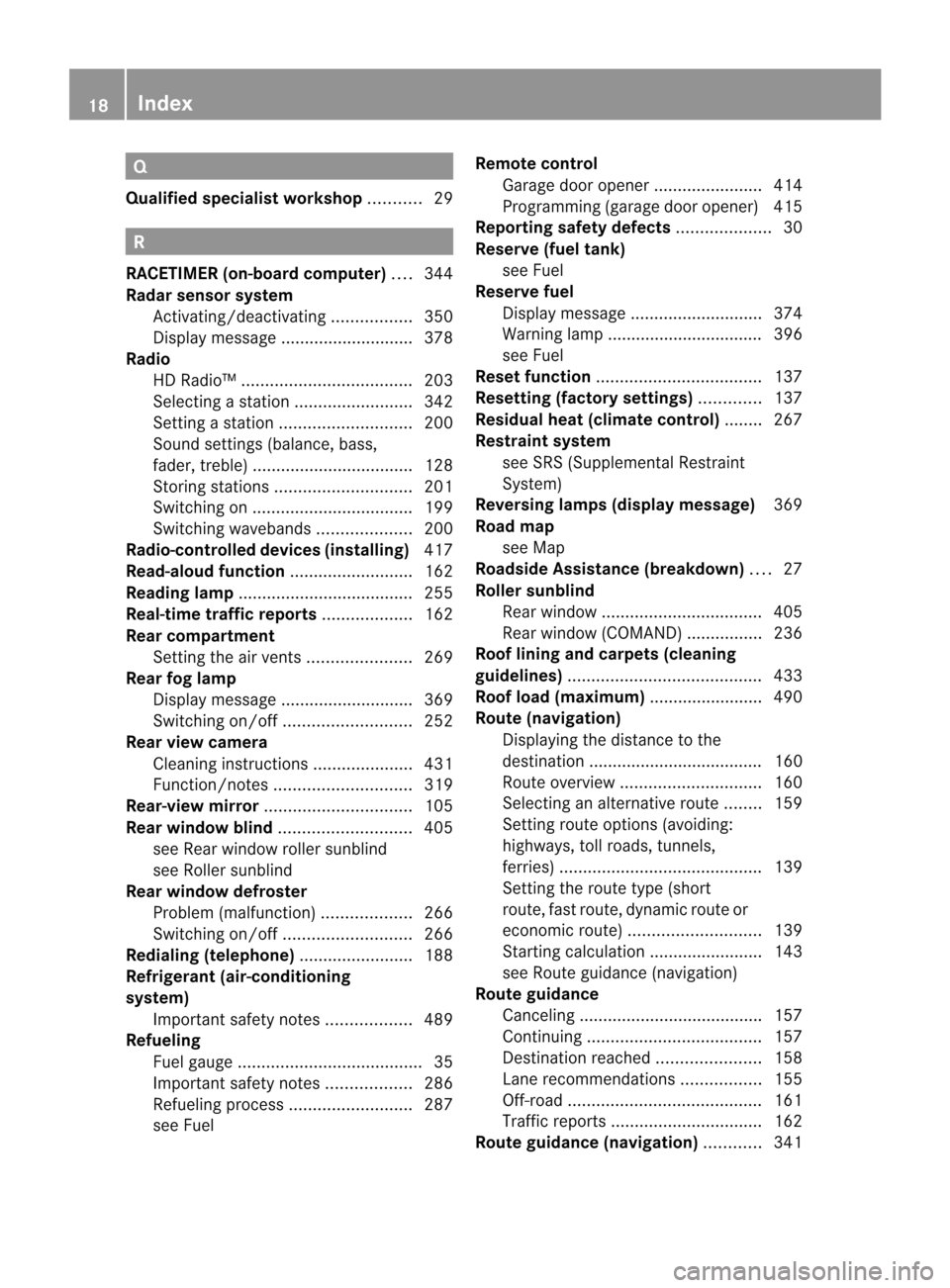
Q
Qualified specialist workshop ...........29 R
RACETIMER (on-board computer) ....344
Radar sensor system Activating/deactivating .................350
Display message ............................ 378
Radio
HD Radio ™.................................... 203
Selecting astation ......................... 342
Setting astation ............................ 200
Sound settings (balance, bass,
fader, treble ).................................. 128
Storing stations ............................. 201
Switching on .................................. 199
Switching wavebands ....................200
Radio-controlled devices (installing) 417
Read-aloud function ..........................162
Reading lamp ..................................... 255
Real-time traffic reports ...................162
Rear compartment Setting the airv ents...................... 269
Rear fog lamp
Display message ............................ 369
Switching on/off ........................... 252
Rear view camera
Cleaning instructions .....................431
Function/notes ............................. 319
Rear-view mirror ............................... 105
Rear window blind ............................405
see Rea rwindow roller sunblind
see Roller sunblind
Rea rwindow defroster
Problem (malfunction) ...................266
Switching on/off ........................... 266
Redialing (telephone) ........................188
Refrigerant (air-conditioning
system)
Important safety notes ..................489
Refueling
Fuel gauge ....................................... 35
Important safety notes ..................286
Refueling proces s.......................... 287
see Fuel Remote control
Garage door opener .......................414
Programming (garage door opener) 415
Reporting safety defects ....................30
Reserve (fuel tank) see Fuel
Reserve fuel
Display message ............................ 374
Warning lamp ................................. 396
see Fuel
Rese tfunction ................................... 137
Resetting (factory settings) .............137
Residual heat (climate control) ........267
Restraint system see SRS (Supplemental Restraint
System)
Reversing lamps (display message) 369
Road map see Map
Roadside Assistance (breakdown) ....27
Roller sunblind Rea rwindow .................................. 405
Rea rwindow (COMAND )................ 236
Roof lining and carpets (cleaning
guidelines) ......................................... 433
Roof load (maximum) ........................490
Route (navigation) Displaying the distance to the
destination ..................................... 160
Route overview .............................. 160
Selecting an alternative route ........159
Setting route options (avoiding:
highways, toll roads, tunnels,
ferries) ........................................... 139
Setting the route type (short
route, fast route, dynamic route or
economi croute) ............................ 139
Starting calculation ........................143
see Route guidance (navigation)
Route guidance
Canceling ...................................... .157
Continuing ..................................... 157
Destination reached ......................158
Lane recommendations .................155
Off-road ......................................... 161
Traffi creports ................................ 162
Route guidance (navigation) ............341 18
Index
Page 21 of 494

Route guidance (on-board
computer)
.......................................... 341
Route information see Dynami croute guidance/TMC S
Safety Children in the vehicle .....................59
Child restraint systems ....................59
Occupant Classification System
(OCS) ............................................... 50
Overview of occupant safety
systems ........................................... 44
Safety notes
Audio CD/DVD and MP3 mode .....209
Operating safety ............................ 110
Video DVD mode ........................... 229
Safety systems
see Driving safety systems
SatRadio ............................................. 205
Displaying information ...................208
Registering .................................... 205
Selecting acategor y...................... 206
Screen
see Display
SD memory card
Loading .......................................... 210
Seat belts
Automatic comfort-fit feature ..........59
Belt force limiters ............................ 59
Cleaning ......................................... 433
Correct usage .................................. 56
Emergency Tensioning Devices ....... .59
Fastening ......................................... 57
Important safety guidelines .............55
Releasing ......................................... 58
Safety guidelines ............................. 45
Specia lseat belt retractor ...............61
Warning lamp ................................. 389
Warning lamp (function) ................... 58
Seats
Active multicontour seat ....... .101, 245
Adjusting (electrically). ....................98
Adjusting lumba rsuppor t.............. 101
Adjusting the head restraint ............99
Cleaning the cover .........................433
Correct driver's seat position ........... 96 Folding the backrests forward/
back ............................................... 100
Important safety notes ....................97
Multicontour sea t.......................... 101
Seat backres tdisplay message .....387
Seat heating problem ....................102
Seat ventilation problem ................102
Selecting (COMAND) .....................244
Storing settings (memory function) 106
Switching sea theating on/off .......101
Switching seat ventilation on/off ..102
Selecting stations (radio)
Using statio npresets ..................... 200
Using statio nsearch ...................... 200
Sending DTMF tones .........................191
Sensors (cleaning instructions) .......431
Service Center see Qualified specialist workshop
Service interval display
Displaying service messages .........426
Hiding service messages ...............426
Notes ............................................. 426
Service messages ..........................426
Service menu (on-board computer) .349
Service products Brake fluid ..................................... 487
Coolant (engine) ............................ 487
Engine oil ....................................... 486
Fuel ................................................ 484
Important safety notes ..................484
Refrigerant (air-conditioning
system) .......................................... 489
Washer fluid .................................. .488
Setting astation (radio)
Via manual frequency entry ...........201
Settings
Display ........................................... 130
Menu overview .............................. 115
On-board computer .......................349
Picture (COMAND) .........................228
Sound settings ............................... 128
System settings ............................. 130
Setting the language
COMAND ....................................... 137
Setting the night design ...................130
Setting the text reader speed ..........132
Setting the vehicle level ...................310 Index
19
Page 46 of 494
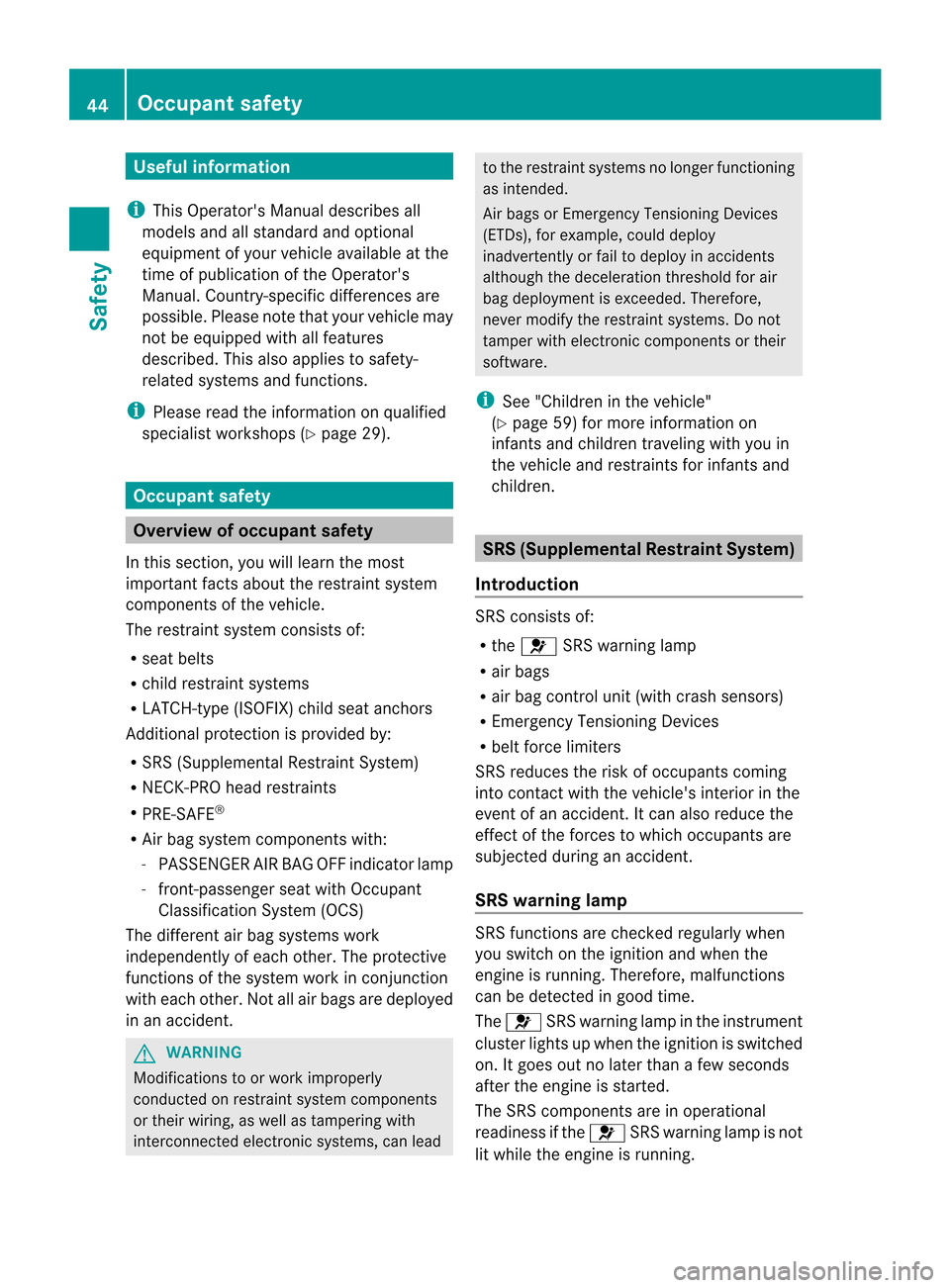
Useful information
i This Operator's Manual describes all
models and all standard and optional
equipment of your vehicle available at the
time of publication of the Operator's
Manual. Country-specific differences are
possible. Please note that your vehicle may
not be equipped with all features
described. This also applies to safety-
related systems and functions.
i Please read the information on qualified
specialist workshops (Y page 29).Occupant safety
Overview of occupant safety
In this section, you will learn the most
important facts about the restraint system
components of the vehicle.
The restraint system consists of:
R seat belts
R child restraint systems
R LATCH-type (ISOFIX) child seat anchors
Additional protection is provided by:
R SRS (Supplemental Restrain tSystem)
R NECK-PRO head restraints
R PRE-SAFE ®
R Airb ag system component swith:
- PASSENGER AI RBAG OFF indicator lamp
- front-passenge rseat with Occupant
Classification System (OCS)
The differen tair bag systems work
independently of each other. The protective
functions of the system work in conjunction
with each other. Not all air bags are deployed
in an accident. G
WARNING
Modifications to or work improperly
conducted on restraint system components
or their wiring, as well as tampering with
interconnected electronic systems, can lead to the restraint systems no longer functioning
as intended.
Air bags or Emergency Tensioning Devices
(ETDs), for example, could deploy
inadvertently or fail to deploy in accidents
although the deceleration threshold for air
bag deploymen tis exceeded. Therefore,
never modify the restraint systems. Do not
tamper with electronic components or their
software.
i See "Children in the vehicle"
(Y page 59) for more information on
infants and children traveling with you in
the vehicle and restraints for infants and
children. SRS (Supplemental Restraint System)
Introduction SRS consists of:
R
the 6 SRS warning lamp
R air bags
R air bag control unit (with crash sensors)
R Emergency Tensioning Devices
R belt force limiters
SRS reduces the risk of occupants coming
into contact with the vehicle's interior in the
event of an accident. It can also reduce the
effect of the forces to which occupants are
subjected during an accident.
SRS warning lamp SRS functions are checked regularly when
you switch on the ignition and when the
engine is running. Therefore, malfunctions
can be detected in good time.
The
6 SRS warning lamp in the instrument
cluster lights up when the ignition is switched
on. It goes out no later than a few seconds
after the engine is started.
The SRS components are in operational
readiness if the 6SRS warning lamp is not
lit while the engine is running. 44
Occupant safetySafety
Page 50 of 494

belts regardless of whether your vehicle is
equipped with air bags or not.
It is important for your safety and that of your
passenger to have deployed air bags replaced
and to have any malfunctioning air bags
repaired. This will help to make sure the air
bags continue to perform their protective
function for the vehicle occupants in the
event of a crash.
Front air bags The fron
tair bags increase protection for the
driver's and front passenger's head and
chest. :
Driver's air bag
; Front-passenger front air bag
= Knee bag
Driver's air bag :deploys in front of the
steering wheel; front-passenger front air
bag ;deploys in front of and above the glove
box.
They are deployed:
R at the start of an accident with a high rate
of vehicle acceleration or deceleration in a
longitudinal direction
R if the system determines that air bag
deploymen tcan offer additional protection
to that provided by the seat belt
R depending on whether the seat belt is being
used
R independently of other air bags in the
vehicle If the vehicle rolls over, the fron
tair bags are
generally not deployed. If the system detects
high vehicle deceleration in alongitudinal
direction, the front air bags are deployed.
Your vehicle has adaptive, two-stage front air
bags. In the event of a collision, the air bag
control unit evaluates the vehicle
deceleration. In the first deployment stage,
the front air bag is filled with enough
propellant gas to reduce the risk of injuries.
The front air bag is fully deployed if a second
deployment threshold is exceeded within a
few milliseconds.
The deployment of the front-passenger front
air bag is also influenced by the weight
category of the front passenger, which is
determined by the Occupant Classification
System (OCS) (Y page 50).
The lighter the passenger-side occupant, the
higher the vehicle deceleration rate required
(predicted at the start of the impact) for
second stage inflation of the front-passenger
front air bag. In the second stage, the front
air bags are inflated with the maximum
amount of propellant gas available.
The front air bags are not deployed in
situations where a low impact severity is
predicted. You will then be protected by the
fastened seat belt.
Front-passenger front air bag ;will only be
deployed if:
R the system, based on the OCS weight
sensor readings, detects that the front-
passenger seat is occupied
R the PASSENGER AIR BAG OFF indicator
lamp on the center console is not lit
(Y page 50)
R the air bag control unit predicts a high
impact severity
Driver's knee bag Driver's knee bag
=(Ypage 48) provides
additional protection for the driver against: 48
Occupant safetySafety
Page 51 of 494

R
knee injuries
R thigh injuries
R lowe rleg injuries
Driver's knee bag =(Ypage 48) deploys
below the steering wheel. During a frontal
impact, if the system determines that air bag
deployment can offer additional protection to
that provided by the seat belt, driver's knee
bag =(Y page 48) is deployed along with the
driver's air bag. Driver's knee
bag=(Y page 48) operates best in
conjunction with a properly positioned and
fastened seat belt.
Side impact air bags G
WARNING
The pressure sensors for side impact air bag
control are located in the doors. Do not
modify any components of the doors or door
trim panels including, for example, the
addition of door speakers.
Improper repair work on the doors or the
modification or addition of components to the
doors create a risk of rendering the side
impact air bags inoperative or causing
unintended air bag deployment .Work on the
doors must therefore only be performed by
qualified technicians. Contact an authorized
Mercedes-Benz Center. G
WARNING
Only use seat covers which have been tested
and approved by Mercedes-Benz for your
vehicle model. Using other seat covers may
interfere with or prevent the deployment of
the side impact air bags. Contact an
authorized Mercedes-Benz Center for
availability. When deployed, the side impact air bags offer
additional protection for the thorax of the
vehicle occupants on the side of the vehicle
on which the impact occurs. However, they
do not protect the:
R
head
R neck
R arms Fronts
ide impac tair bags :and rear side
impac tair bags ;deploy nex tto the outer
seat cushions.
The side impact air bags are deployed:
R on the side on which an impact occurs
R at the start of an accident with a high rate
of lateral vehicle deceleration or
acceleration, e.g. in aside impact
R independently of the use of the seat belt
R independently of the front air bags
R independently of the ETDs
If the vehicle overturns, the side impac tair
bags are generally not deployed. Exception: if
the system detects high vehicle deceleration
or acceleration in a lateral direction and
determines that deploymen tcan offer
additional protection to that provided by the
seat belt.
Side impac tair bags will not deploy in side
impacts which do not exceed the system's
prese tdeployment thresholds for lateral
acceleration/deceleration .You will then be
protected by the fastened seat belt. Occupant safety
49Safety Z
Page 52 of 494
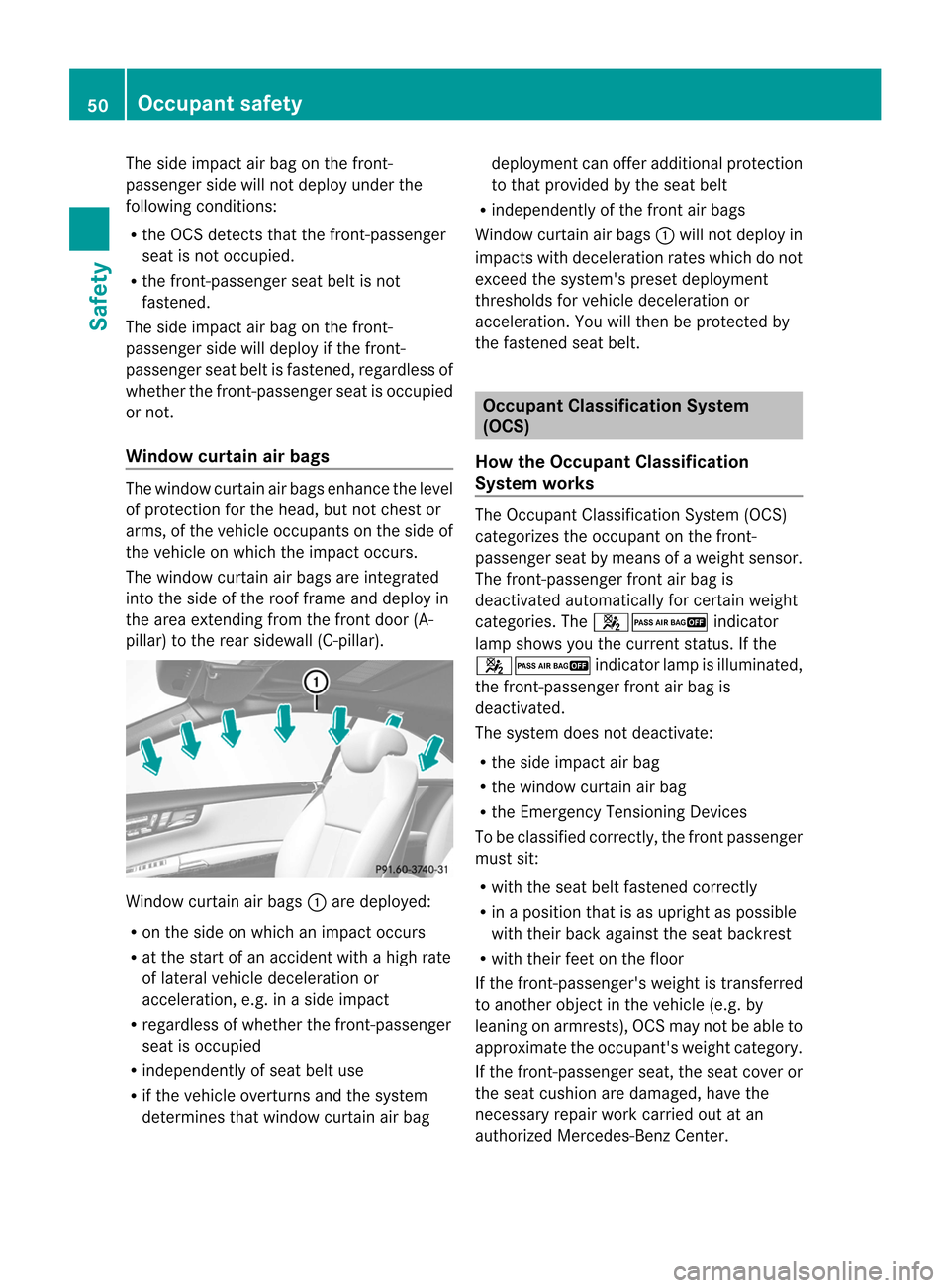
The side impact air bag on the front-
passenger side will not deploy under the
following conditions:
R
the OCS detects that the front-passenger
seat is not occupied.
R the front-passenger seat belt is not
fastened.
The side impact air bag on the front-
passenger side will deploy if the front-
passenger seat belt is fastened, regardless of
whether the front-passenger seat is occupied
or not.
Window curtain air bags The window curtain air bags enhance the level
of protection for the head, but not chest or
arms, of the vehicle occupants on the side of
the vehicle on which the impact occurs.
The window curtain air bags are integrated
into the side of the roof frame and deploy in
the area extending from the front door (A-
pillar) to the rear sidewall (C-pillar). Window curtain air bags
:are deployed:
R on the side on which an impact occurs
R at the start of an accident with a high rate
of lateral vehicle deceleration or
acceleration, e.g. in aside impact
R regardless of whether the front-passenger
seat is occupied
R independently of seat belt use
R if the vehicle overturns and the system
determines that window curtain air bag deploymen
tcan offer additional protection
to that provided by the seat belt
R independently of the fron tair bags
Window curtain air bags :will not deploy in
impacts with deceleration rates which do not
exceed the system's prese tdeployment
thresholds for vehicle deceleration or
acceleration. You will then be protected by
the fastened seat belt. Occupant Classification System
(OCS)
How the Occupant Classification
System works The Occupant Classification System (OCS)
categorizes the occupant on the front-
passenger seat by means of a weight sensor.
The front-passenger fron tair bag is
deactivated automatically for certain weight
categories. The 42 indicator
lamp shows you the current status. If the
42 indicator lamp is illuminated,
the front-passenger front air bag is
deactivated.
The system does not deactivate:
R the side impac tair bag
R the window curtain air bag
R the Emergency Tensioning Devices
To be classified correctly, the front passenger
must sit:
R with the seat belt fastened correctly
R in a position that is as upright as possible
with their back against the seat backrest
R with their feet on the floor
If the front-passenger's weight is transferred
to another object in the vehicle (e.g .by
leaning on armrests), OCS may not be able to
approximate the occupant's weight category.
If the front-passenger seat, the seat cover or
the seat cushio nare damaged, have the
necessary repair work carried out at an
authorized Mercedes-Benz Center. 50
Occupant safetySafety
Page 53 of 494
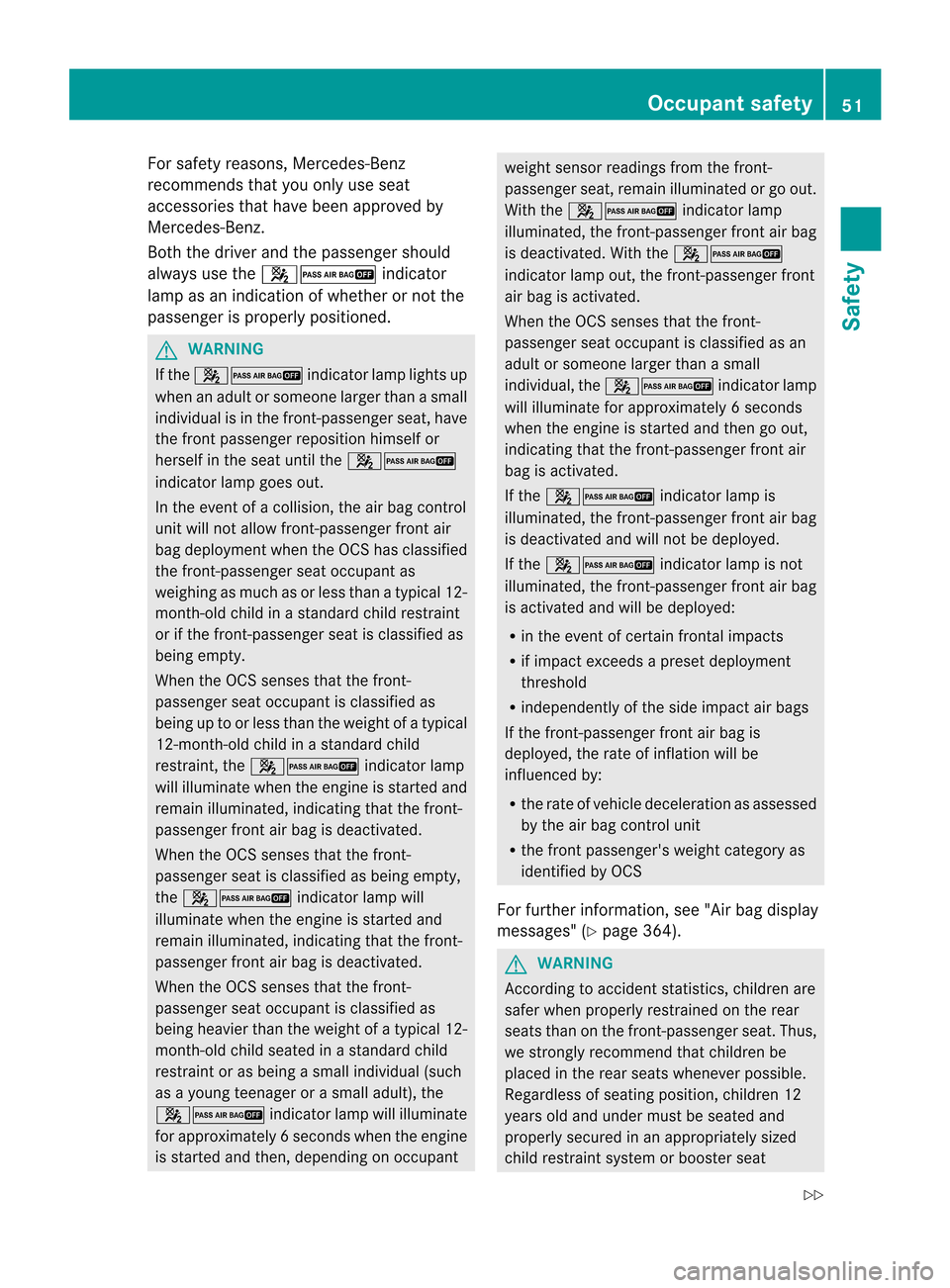
For safety reasons, Mercedes-Benz
recommends that you only use seat
accessories that have bee napproved by
Mercedes-Benz.
Both the driver and the passenger should
always use the 42 indicator
lamp as an indication of whether or not the
passenger is properly positioned. G
WARNING
If the 42 indicator lamp lights up
when an adult or someone larger than a small
individual is in the front-passenger seat, have
the fron tpassenger reposition himself or
herself in the seat until the 42
indicator lamp goes out.
In the event of a collision, the air bag control
unit will no tallow front-passenge rfront air
bag deployment when the OCS has classified
the front-passenge rseat occupant as
weighing as much as or less than a typical 12-
month-old child in a standard child restraint
or if the front-passenger seat is classified as
being empty.
When the OCS senses that the front-
passenger seat occupant is classified as
being up to or less than the weight of a typical
12-month-old child in a standard child
restraint, the 42 indicator lamp
will illuminate when the engine is started and
remain illuminated, indicating that the front-
passenger fron tair bag is deactivated.
When the OCS senses that the front-
passenger seat is classified as being empty,
the 42 indicator lamp will
illuminate when the engine is started and
remain illuminated, indicatin gthat the front-
passenger front air bag is deactivated.
When the OCS senses that the front-
passenger seat occupant is classified as
being heavier than the weight of a typical 12-
month-old child seated in astandard child
restraint or as being a small individual (such
as a young teenager or asmall adult), the
42 indicator lamp will illuminate
for approximately 6seconds when the engine
is started and then, depending on occupant weight sensor readings from the front-
passenger seat, remain illuminated or go out.
With the
42 indicator lamp
illuminated, the front-passenger fron tair bag
is deactivated. With the 42
indicator lamp out, the front-passenger front
air bag is activated.
When the OCS senses that the front-
passenger seat occupant is classified as an
adult or someone larger than a small
individual, the 42 indicator lamp
will illuminate for approximately 6seconds
when the engine is started and then go out,
indicating that the front-passenger front air
bag is activated.
If the 42 indicator lamp is
illuminated, the front-passenger fron tair bag
is deactivated and will not be deployed.
If the 42 indicator lamp is not
illuminated, the front-passenge rfront air bag
is activated and will be deployed:
R in the event of certain frontal impacts
R if impact exceeds a preset deployment
threshold
R independently of the side impact air bags
If the front-passenger front air bag is
deployed, the rate of inflation will be
influenced by:
R the rate of vehicle deceleratio nas assessed
by the air bag control unit
R the front passenger's weight category as
identified by OCS
For further information, see "Air bag display
messages" (Y page 364). G
WARNING
According to accident statistics, children are
safer when properly restrained on the rear
seats than on the front-passenger seat. Thus,
we strongly recommend that children be
placed in the rear seats whenever possible.
Regardless of seating position, children 12
years old and under must be seated and
properly secured in an appropriately sized
child restraint system or booster seat Occupant safety
51Safety
Z